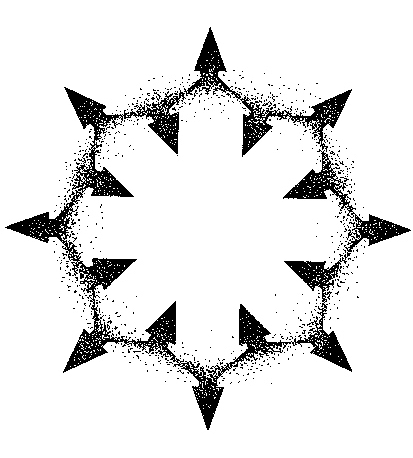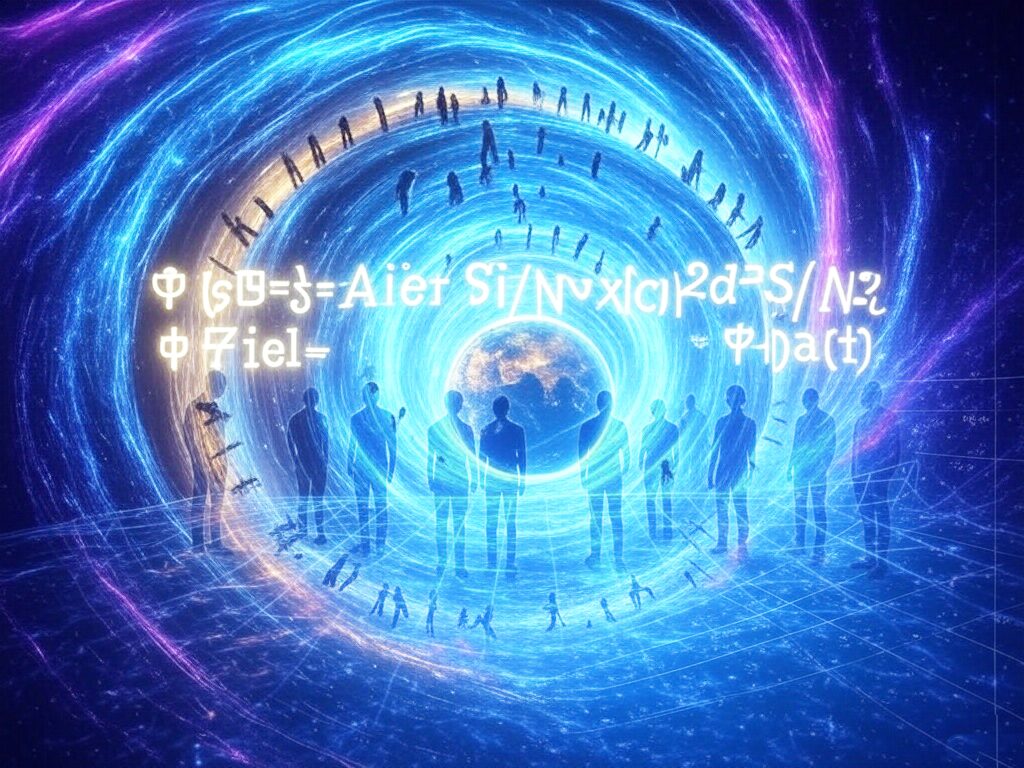Core Idea: Human behavior arises from a chaotic, non-linear interplay of individual actions, collective paradigms, and an underlying holistic order, modeled with quantum-like principles and informed by chaos theory.
Drawing from T.R. Young’s chaos and non-linear socio-dynamics, behavior is not fully predictable but exhibits strange attractors—patterns that emerge from conflict, power struggles, and social turbulence. Thomas Kuhn’s concept of paradigms provides structure, David Bohm’s implicate order connects the system holistically, and the QIH framework quantifies interference and feedback. Together, they suggest that behavior oscillates between order and chaos, shaped by non-linear feedback loops.
- T.R. Young’s Contribution (Chaos and Non-Linear Socio-Dynamics): Young argues social systems are non-linear, with small changes (e.g., a single act of resistance) potentially causing disproportionate effects (e.g., revolutions). Chaos theory introduces attractors—stable tendencies like cooperation or conflict—that emerge from turbulent social interactions, replacing the QIH’s “butt state” with “social momentum.”
- Thomas Kuhn’s Contribution: Paradigms act as temporary stabilizing structures within chaotic social dynamics, guiding behavior until anomalies (misalignments) trigger shifts.
- David Bohm’s Contribution: An implicate order underlies the chaos, holographically linking individuals and unfolding into observable behavior, akin to Young’s notion of emergent patterns.
- QIH Framework: Human behavioral states are encoded as quantum-like vectors, with interference and feedback loops reflecting the non-linear amplification or dampening of social trends.
Key Prediction: Behavior follows probabilistic trajectories influenced by chaotic initial conditions, collective histories, and paradigm coherence. Non-linear feedback loops and strange attractors govern whether groups stabilize or dissolve into chaos.
Mathematical Framework for SQBS
The equations adapt QIH to include Young’s chaos theory, emphasizing non-linearity and sensitivity to initial conditions.
1. Behavioral State Encoding
Each person’s behavioral state is a vector in a chaotic “social phase space”:
- v_x = c \cos(\theta) + \epsilon_x
: Momentum alongthe “conformity” axis, perturbed by chaos.
- v_y = c \sin(\theta) + \epsilon_y
: Momentum along the “innovation/conflict” axis.
- v_z = c \sin(\phi) + \epsilon_z
: Momentum along the “paradigm adherence” axis.
Where:
- ( c ) is the “speed of social influence” (context-specific, e.g., communication rate).
- \theta
is the angle of alignment with the dominant social momentum (Young’s power dynamics).
- \phi
is the angle of paradigm acceptance (Kuhn’s influence).
- \epsilon_x, \epsilon_y, \epsilon_z
are chaotic perturbations (small random inputs with potentially large effects, per Young’s non-linearity).
2. Wavefunction Interference (Non-Linear Response)
The probability of aligning with or resisting the collective is modulated by interference and chaos:
- P_{\text{align}} = |\psi|^2 = \cos^2(\theta/2) \cdot e^{-\alpha |\epsilon|}
: Probability of conformity, damped by chaotic noise.
- P_{\text{misalign}} = |\psi|^2 = \sin^2(\theta/2) \cdot (1 + \beta |\epsilon|)
: Probability of resistance, amplified by chaos.
Where:
- \alpha
and
\beta
are coefficients of chaotic damping and amplification (Young’s non-linear effects).
- |\epsilon|
is the magnitude of chaotic perturbation.
Alignment occurs when an individual’s state matches the collective’s “leading momentum,” but chaos can disrupt this.
3. Sum of Histories (Chaotic Trajectories)
Behavior integrates past interactions with non-linear weighting:
- \psi_{\text{group}} = \sum_{i=1}^{N} A_i e^{i S_i / \hbar} + \chi(t)
Where:
- ( N ) is the number of individuals.
- A_i
is the influence amplitude (e.g., social power, per Young).
- S_i
is the action of the behavioral trajectory, encoding past conflicts and interactions.
- \hbar
is a socio-quantum constant (behavioral inertia).
- \chi(t)
is a time-dependent chaotic term (e.g., a logistic map,
\chi_{n+1} = r \chi_n (1 – \chi_n)
), reflecting Young’s emphasis on unpredictable dynamics.
This captures Bohm’s implicate order as a substrate perturbed by chaos.
4. Holographic Feedback Loop (Non-Linear Amplification)
Behavior is reinforced through a chaotic, holographic entanglement:
- \psi_{\text{total}} = \int \psi_{\text{state}} e^{i \phi} e^{\lambda |\epsilon|^2} \, d\tau
Where:
- \psi_{\text{state}}
is the individual’s behavioral state.
- \phi
is the phase of the “leading momentum” (e.g., a cultural trend or leader).
- \lambda
is a non-linear feedback parameter (amplifying small perturbations, per Young).
- \tau
is time or interaction steps.
The exponential term
e^{\lambda |\epsilon|^2}
reflects Young’s insight that small initial differences can lead to exponential divergence (chaos).
5. Strange Attractor and Paradigm Shift
Inspired by Young’s chaos and Kuhn’s shifts, behavior converges to attractors or diverges:
- Attractor Strength:
A_s = \frac{P_{\text{align}}}{P_{\text{misalign}} + |\chi(t)|}
- Shift Trigger:
|\chi(t)| > \kappa
or
P_{\text{misalign}} > P_{\text{align}} + \delta
Where:
- A_s
measures the stability of a behavioral pattern (e.g., cooperation as an attractor).
- \kappa
and
\delta
are thresholds for chaotic disruption or paradigm collapse.
When
|\chi(t)|
exceeds
\kappa
, the system bifurcates (Young’s chaos), potentially aligning with a new paradigm (Kuhn).
Application Example: Predicting a Social Movement
Consider a labor strike:
- Behavioral States: Workers
v_x, v_y, v_z
reflect frustration (
\theta
) and paradigm rejection (
\phi
), with
\epsilon
from random events (e.g., a viral video).
- Interference: High
P_{\text{misalign}}
grows as chaos (
\beta |\epsilon|
) amplifies dissent (Young’s conflict).
- Histories: Past labor disputes (
S_i
) and chaotic triggers (
\chi(t)
) boost
\psi_{\text{group}}
.
- Feedback Loop: Leaders or media adjust
\phi
, but
\lambda |\epsilon|^2
escalates the movement.
- Attractor/Shift: If
A_s
weakens and
|\chi(t)| > \kappa
, a new labor paradigm emerges.
Summary
The revised SQBS theory predicts human behavior as a chaotic, non-linear system, blending Young’s chaos theory (strange attractors, sensitivity to conditions), Kuhn’s paradigms (temporary order), Bohm’s holism (holographic unity), and QIH’s quantum framework (interference and feedback). Behavior oscillates between attractors (e.g., stability) and chaos (e.g., upheaval), with equations capturing probabilities rather than certainties. Empirical calibration of
c, \alpha, \beta, \lambda, \kappa
would require data on social interactions, but the model highlights how small acts can cascade into major shifts—a hallmark of Young’s non-linear socio-dynamics.


Leave a Reply